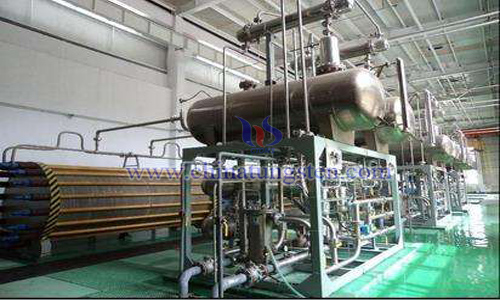Hydrogen Production from Supported Nickel-Tungsten Bimetallic Composite Oxides
- Details
- Category: Tungsten Information
- Published on Wednesday, 07 August 2019 22:59
With the rapid rise of global energy demand and the increasing problem of greenhouse gas emissions, the deployment of hydrogen energy industry has become one of the important strategies to solve the sustainable development of society, economy and environment. Hydrogen is widely used to synthesize and upgrade liquid fuels to replace traditional petroleum to produce gasoline and diesel. Meanwhile, proton exchange membrane fuel cells (PEMFCs) fueled with hydrogen have high energy conversion efficiency, and the byproduct is only water, which is expected to become the power core of a new generation of vehicles.

As an advanced and efficient thermochemical technology, chemical chain technology can realize in-situ separation of near-zero energy consumption of products while converting fuels. It has been widely concerned that metal oxides are solid materials that are continuously recycled between reactors in the chemical chain process, and transfer oxygen atoms and oxygen atoms between fuel and water or air. Reaction heat is the key to the development of chemical chain technology. At present, single metal oxide is the main active component, such as iron oxide.
Some scholars use a supported nickel-tungsten bimetallic composite oxide to produce hydrogen. The preparation method is carried out according to the following steps:
Step 1: Ultrasound was used to dissolve 0.4867-1.4540 parts of nickel nitrate hexahydrate (Ni (NO3)2·6H2O), 1.9828 parts of tungsten hexachloride (WCl6) and 12.7903 parts of aluminium nitrate hexahydrate (Al (NO3)3·9H2O) in ethanol.
Step 2: NaOH granules were volumed in a volumetric bottle with ultra-pure water at a constant volume of 0.5-1M.
Step 3: Under the condition of magnetic stirring, the solution of step 1 and step 2 was mixed slowly at the same time until the pH was 9-10, and the flocculent sediment was stationary for 1-2 hours at room temperature.
Step 4: Centrifuge, filter and wash the flocculent sediment after step 3 is stationary for 5-6 times with ethanol and distilled water, until the pH is 7-8.
Step 5: The material obtained in step 4 is dried for 8-12 hours at room temperature, then for 8-12 hours at 70-90 degrees C, and finally calcined for 4-6 hours at 600-800 degrees C to obtain nickel-tungsten bimetallic composite oxide loaded on alumina.
Supported nickel-tungsten bimetallic oxides are used in direct hydrogen production by self-heating in a three-bed chemical chain. The total reaction of the system is equivalent to the strong exothermic reaction of the reaction of fuel with oxygen to produce CO2 and H2O. The heat released can be used as the heat required for hydrogen production by steam reforming of fuel. So by adjusting the ratio of air to water vapor and the ratio of nickel to tungsten bimetallic oxide in the system, the production of hydrogen by self-heating or the co-production of hydrogen and heat (electricity) can be realized. At the same time, near zero energy consumption can be used to produce H2 and separate CO2.
- Tungsten Oxide Manufacturer & Supplier, Chinatungsten Online: www.tungsten-oxide.com
- Tungsten News & Prices of China Tungsten Industry Association: www.ctia.com.cn
- Molybdenum News & Price: news.molybdenum.com.cn
- Tel.: 86 592 5129696; Fax: 86 592 5129797; Email: sales@chinatungsten.com



 sales@chinatungsten.com
sales@chinatungsten.com